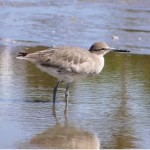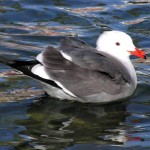COMMONLY SEEN BIRDS OF BALLONA CREEK
The many kinds of birds seen foraging in the creek attract many visitors. Some are permanent residents, others are migratory and visit only during certain seasons. Below are those most commonly seen in and around the creek. Click on the small photos to bring up larger ones. (Photos by Marina Tidwell except where noted):
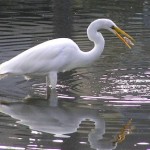 Herons and Egrets. These are certainly the most noticeable and dramatic birds found in the creek, with long legs, long necks and spear-like bills. Wading in the
Herons and Egrets. These are certainly the most noticeable and dramatic birds found in the creek, with long legs, long necks and spear-like bills. Wading in the 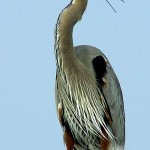 creek, they eat fish and invertebrates. They may be found in nearby fields and trees and also feed on mice and insects. The Great Blue Heron (actually, bluish-grey) grows to about 4 feet tall and nests in trees — like a gigantic Scrub jay. Its white cousins are the Great Egret (up to 38” tall) and Snowy Egret (up to 27” tall).
creek, they eat fish and invertebrates. They may be found in nearby fields and trees and also feed on mice and insects. The Great Blue Heron (actually, bluish-grey) grows to about 4 feet tall and nests in trees — like a gigantic Scrub jay. Its white cousins are the Great Egret (up to 38” tall) and Snowy Egret (up to 27” tall).
The Great Egret has a yellow beak, black feet and a long sinewy neck, while the
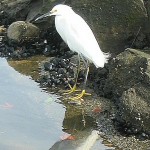 shorter Snowy Egret (photo by Bobbi Gold) has a black beak and bright yellow feet. The black-crowned night heron has short legs, neck and beak and is nocturnal, seen at dawn or dusk at low tides along the creek rocks as well as at night in the adjoining wetlands. The voices of herons and egrets are
shorter Snowy Egret (photo by Bobbi Gold) has a black beak and bright yellow feet. The black-crowned night heron has short legs, neck and beak and is nocturnal, seen at dawn or dusk at low tides along the creek rocks as well as at night in the adjoining wetlands. The voices of herons and egrets are 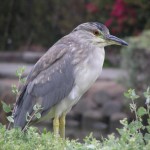 rather harsh croaks- they’re definitely not songbirds. They tend to be somewhat solitary and may squabble over feeding territory.
rather harsh croaks- they’re definitely not songbirds. They tend to be somewhat solitary and may squabble over feeding territory.
Willets and Marbled Godwits. These similar-sized sandpipers (17-20”) often flock together on the rocks at the sides of the creek.
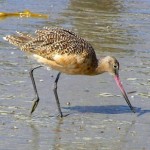 The Marbled Godwit has a mottled cinnamon brown appearance and a long, slightly upturned bill that’s pink near the head and black at the tip. The willet is rather nondescript brown-grey (with black and white “spangles” in breeding plumage) but, when it takes flight, striking black and white bands on its wings are revealed.
The Marbled Godwit has a mottled cinnamon brown appearance and a long, slightly upturned bill that’s pink near the head and black at the tip. The willet is rather nondescript brown-grey (with black and white “spangles” in breeding plumage) but, when it takes flight, striking black and white bands on its wings are revealed.
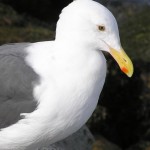
Gulls. (not “seagulls”). There are many different species of gull locally, the most common being the Western Gull. Juveniles are darker and mottled overall.
Depending on species, gulls take 2 to 4 years to transition to adult plumage (white body with dark grey wings). The Western Gull is an opportunistic scavenger that eats many natural things plus corn chips and anything left unguarded on a beach blanket or plate. At the left is a red-beaked Heerman’s Gull.
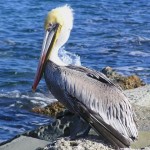
Pelicans. Clumsy on land but graceful in the air, brown pelicans dive from the air into the water for fish. The sac of skin beneath the lower beak can hold much more fish than their stomachs. Adults are generally silent away from the nest. These birds were listed as endangered in the 1970s due to poisoning by DDT in the environment, but have made a spectacular comeback in the past few decades.
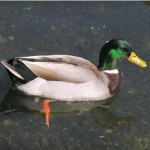
Mallards and other ducks. These familiar birds are usually monogamous. They eat Insects and larvae, aquatic invertebrates, seeds, acorns, aquatic plants and grain. A great many ducks spend the fall and winter here in Ballona and nearby, migrating from their breeding grounds in the north. Pintails, Buffleheads, Mergansers, Scaups are just a few wintering ducks you may spot.
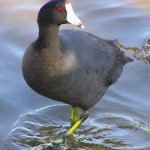
American Coots. This black, chicken-size bird with a triangular white beak and red eyes swims and dives like a duck but isn’t a duck, it’s a rail. It’s often seen in large flocks. Its greenish feet have lobed toes, not webbed feet. They eat plants, fish, and invertebrates. Because of their round bodies and short wings, they need a lot of effort to get airborne, so if you see a coot coming at you trying to gain altitude, duck!
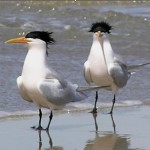
Terns. Several species of terns frequent Ballona in different seasons.
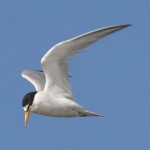
In summer one sees the Elegant Tern and the Least (smallest) Tern. In fall and spring you may see the large Caspian or Royal terns as they migrate through the area. Terns hover over the water, then dive for fish. (Least tern photo from U.S. Fish and Wildlife Service digital library.)
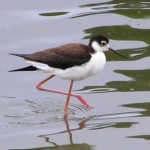
Black-necked stilts. These distinctive birds are black on the back, neck and wings, white elsewhere, with long red or pink legs. They feed on insects, fish, worms, small crustaceans and seeds. They’re often found in parts of the creek with a concrete bottom, poking around algae for the invertebrates that the algae shelters. They hang out in flocks and make a racket of screeches when they take flight.
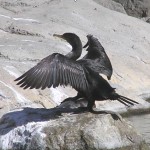
Cormorants. These dark birds are swimmers with webbed feet, riding low in the water. They dive for fish from the water’s surface, rather than from the air. They’re often seen perched on rocks, holding their wings out to dry because, unlike most water birds, the cormorant’s feathers are not “waterproof.” Several species of cormorants are found in and around the creek.
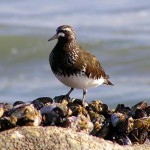
Turnstones. Turnstones do exactly what their name suggests, turning over stones to find insects, worms and other invertebrates to eat. They come in two color varieties: a mottled black and a ruddy version with red legs and red wing patches. The latter spends summers in the arctic.
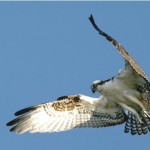
Osprey. The osprey is a large raptor, with a wingspan of 4-6 ft. It eats live fish almost exclusively, hovering high above the water, then plunging in talons first, but may eat small mammals, reptiles and other birds. Ospreys build nests on structures such as utility poles, artificial platforms, in forks of trees, or rocky outcrops. Like pelicans, their numbers drastically declined due to DDT contaminations, but populations have recovered in recent decades. (Photo- US Fish & Wildlife Service)
More birds seen around the channel (for your own research):
Whimbrel
Surfbirds
Curlew (rare)
Grebe (5 species!)
Black Oystercatcher
Dowitcher
Lesser Yellowlegs (winter visitor)

